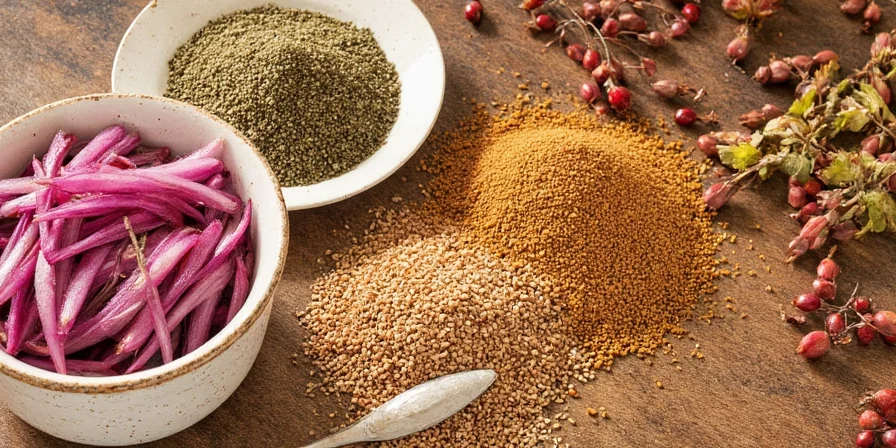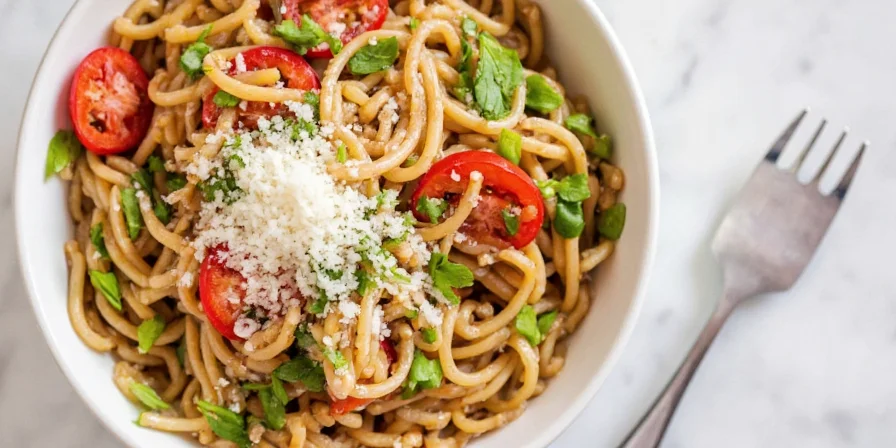How to Master Umami Flavors in Your Kitchen

Have you ever wondered why some dishes just hit that perfect spot in your mouth—deep, savory, and almost addictive? The answer lies in umami, the fifth taste that brings depth and richness to your food. While umami is often associated with ingredients like aged cheese, mushrooms, and soy sauce, it's also closely tied to the right spices. In this blog post, we’ll dive into the world of umami, explore the spices that amplify it, and give you a list of spice storage and usage hacks that will elevate your cooking to the next level.
What Exactly Is Umami?
Umami is a Japanese term that translates to “deliciousness” or “the essence of taste.” Unlike the other four basic tastes—sweet, salty, sour, and bitter—umami is more about depth and richness. It's the flavor that makes you go back for seconds, and it's what gives dishes like miso soup, Parmesan cheese, and beef broth their unforgettable savoriness.
The primary compounds responsible for umami are glutamates (found in mushrooms, tomatoes, and fermented foods), inositols (found in eggs and meat), and nucleotides (found in seafood and dried mushrooms). But here's the kicker: certain spices can enhance these umami compounds, making your dishes even more flavorful.
The Spice That Boosts Umami: Miso Paste
When it comes to spices that amplify umami, miso paste is a standout. This fermented soybean paste is a staple in Japanese cuisine and is packed with amino acids, glutamates, and other compounds that give it that deep, savory flavor. Miso is not just a sauce—it's a flavor booster that can transform simple dishes into umami-packed masterpieces.
There are several types of miso, each with its own flavor profile:
| Type of Miso | Flavor Profile | Best For |
|---|---|---|
| White Miso | Mild, sweet, and slightly salty | Soups, dressings, and marinades |
| Red Miso | Strong, salty, and deeply savory | Stews, braises, and grilled dishes |
| Awase Miso | A blend of white and red miso for a balanced flavor | General cooking and baking |
Choosing the right type of miso can make all the difference in your cooking. White miso is milder and better suited for delicate dishes, while red miso offers a bolder, more intense flavor. Awase miso is a great all-rounder for those who want a little of both worlds.
Spice Storage & Usage Hacks for Miso Paste
Now that we've established that miso paste is a key player in the umami game, let's get into the nitty-gritty: how to store it and use it effectively. Proper storage is crucial to preserving the flavor and potency of your spices, and miso is no exception.
Storage Tips for Miso Paste
- Keep it cool: Miso paste should be stored in a cool, dark place, such as the refrigerator. Heat can break down the amino acids and reduce the umami impact.
- Seal it tightly: Make sure the container is airtight to prevent moisture and air from getting in. Exposure to air can cause the paste to dry out and lose its flavor.
- Use a glass jar: Glass jars are better for preserving the quality of miso paste than plastic containers. They are non-reactive and help maintain the paste's integrity.
- Label and date: Miso paste can last for a long time, but it's always a good idea to label the jar with the date you opened it. That way, you can keep track of its freshness and use it before it starts to lose its potency.
Usage Tips for Miso Paste
- Use it in soups and stews: Miso paste is a classic ingredient in Japanese soups like miso soup. Add a spoonful to your soup and let it simmer for a few minutes to let the flavors develop.
- Marinate meats with it: Miso paste is a fantastic marinade for chicken, pork, and even fish. Its saltiness and umami flavor help tenderize the meat and add incredible depth to the dish.
- Use it in dressings and sauces: Mix miso paste with rice vinegar, sesame oil, and a touch of sugar to make a quick and flavorful dressing for salads or grilled vegetables.
- Use it in baking: Believe it or not, miso paste can be used in baking. It adds a savory depth to dishes like miso caramel, which is a popular dessert in Japan.
Other Umami-Boosting Spices to Know
While miso paste is a powerhouse of umami, it's not the only spice that can enhance the savory depth of your dishes. Here are a few other umami-boosting spices that you should have in your kitchen:
1. Soy Sauce
Soy sauce is another umami-rich ingredient that can dramatically enhance the flavor of your food. It contains glutamates and amino acids that give it that deep, savory taste. Dark soy sauce is more intense and better suited for braising and roasting, while light soy sauce is milder and better for stir-fries and dipping sauces.
2. Fish Sauce
Fish sauce is a staple in Southeast Asian cuisine and is packed with umami. It's made from fermented fish and salt, which gives it a bold, salty, and savory flavor. A little bit of fish sauce can go a long way in enhancing the depth of flavor in your dishes.
3. Dried Mushrooms
Dried mushrooms, especially shiitake, are a great source of umami. They contain glutamates and other compounds that give them their deep, earthy flavor. Rehydrating dried mushrooms in hot water before using them in soups or stews can unlock their full umami potential.
4. Parmesan Cheese
Believe it or not, Parmesan cheese is a source of umami. It contains glutamates that give it that rich, savory flavor. Grating a little Parmesan over your pasta, risotto, or even salads can add a layer of umami that elevates the dish.
Storage and Usage Tips for Other Umami-Boosting Spices
Now that we've covered some of the umami-boosting spices, let's take a look at how to store and use them effectively. Proper storage is key to preserving the flavor and potency of your spices, and each one has its own requirements.
Storage Tips for Soy Sauce
- Keep it refrigerated: Once opened, soy sauce should be stored in the refrigerator to prevent spoilage and maintain its flavor.
- Use a glass bottle: Glass bottles are better for storing soy sauce than plastic. They are non-reactive and help maintain the sauce's integrity.
- Seal it tightly: Make sure the bottle is airtight to prevent moisture and air from getting in. Exposure to air can cause the sauce to dry out and lose its flavor.
Storage Tips for Fish Sauce
- Store it in a cool, dark place: Fish sauce can be stored in a cool, dark place, such as a pantry or cabinet, as long as it's sealed tightly.
- Use a glass bottle: Fish sauce is highly concentrated and has a strong aroma, so it's best stored in a glass bottle to prevent any unwanted odors from seeping in.
- Seal it tightly: Make sure the bottle is airtight to prevent moisture and air from getting in. Exposure to air can cause the sauce to oxidize and lose its potency.
Storage Tips for Dried Mushrooms
- Store them in an airtight container: Dried mushrooms should be stored in an airtight container to prevent moisture and air from getting in. Exposure to air can cause them to become brittle and lose their flavor.
- Keep them in a cool, dark place: Dried mushrooms should be stored in a cool, dark place, such as a pantry or cabinet. Heat can cause them to degrade and lose their umami potential.
Storage Tips for Parmesan Cheese
- Store it in the refrigerator: Parmesan cheese should be stored in the refrigerator to prevent it from drying out and losing its flavor.
- Wrap it in parchment paper: Parmesan cheese should be wrapped in parchment paper rather than plastic. This helps prevent it from absorbing unwanted odors and keeps it fresh for longer.
- Use a glass container: If you're storing grated Parmesan cheese, it's best to use a glass container to maintain its texture and flavor.
Maximizing Umami in Your Cooking
Now that we've covered the best umami-boosting spices and how to store and use them, let's take a look at some practical tips for maximizing umami in your cooking. Here are a few simple techniques that can help you unlock the full flavor of your ingredients:
- Combine umami sources: Combining different umami sources can create a powerful flavor synergy. For example, adding a splash of soy sauce and a sprinkle of Parmesan cheese to your pasta can create a rich, savory depth that's hard to beat.
- Let flavors develop: Letting your dishes sit for a while after cooking can allow the flavors to develop and deepen. This is especially true for soups and stews, where the umami compounds have time to meld together.
- Use umami as a seasoning: Umami can be used as a seasoning to enhance the flavor of your dishes. A little bit of miso paste or fish sauce can go a long way in adding depth and richness to your food.
- Experiment with different umami sources: Don't be afraid to experiment with different umami sources. Try adding a bit of dried mushrooms to your soup or a dash of soy sauce to your stir-fry. You might be surprised at how much of a difference it makes.
Conclusion: Embrace the Power of Umami
Umami is more than just a flavor—it's a flavor experience that can transform your cooking. By understanding the spices that enhance umami and learning how to store and use them effectively, you can unlock the full potential of your ingredients and create dishes that are rich, flavorful, and unforgettable.
So the next time you're in the kitchen, don't be afraid to experiment with umami. Whether it's a splash of soy sauce, a drizzle of miso paste, or a sprinkle of Parmesan cheese, these simple additions can take your cooking to the next level. Embrace the power of umami and enjoy the delicious results!

Happy cooking!










 浙公网安备
33010002000092号
浙公网安备
33010002000092号 浙B2-20120091-4
浙B2-20120091-4